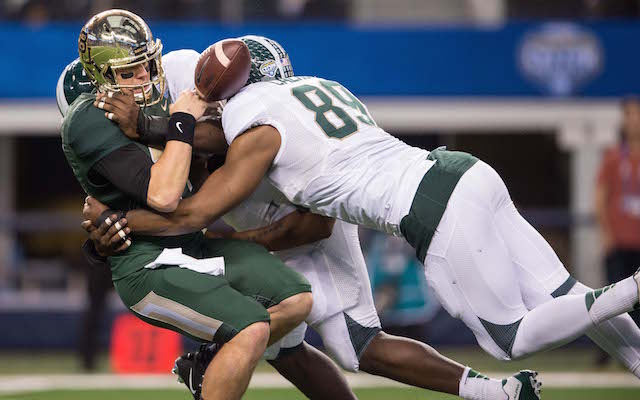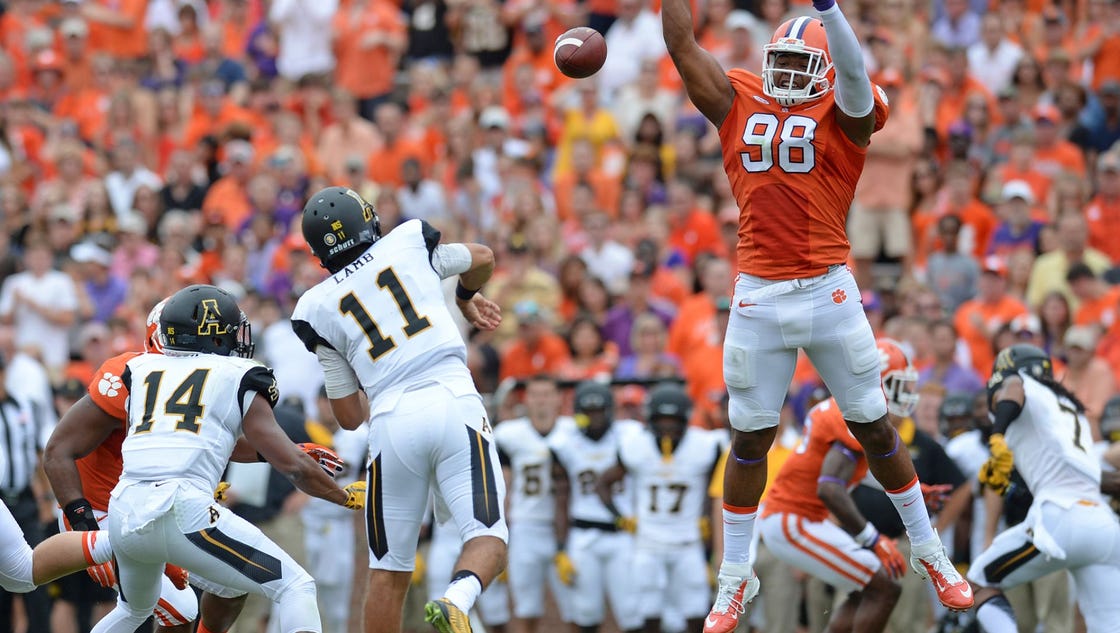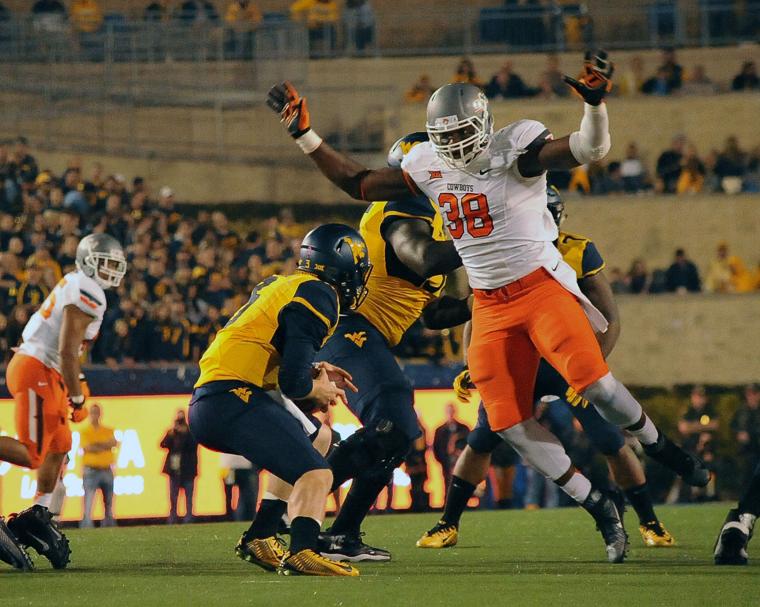Pass rusher is one of the
preeminent positions in the NFL, and this year provides a class that combines
top tier talent with quality depth. Many have called this the strongest
position in the class, and while I’m lower on it than most, I still see a lot of
talent from the beginning to the end of the first round.
When judging pass rushing
prospects, athleticism is often the first thing teams look for. And while there
is strong evidence that this is a reasonable approach, a talented athlete is
all the more valuable if he comes with technique to go along with his natural
skills. Pass rushers need to be able to explode up the field, but they also
need to be able to use their hands to generate separation from the blockers.
They need to be strong to bend against pressure to the middle of the field, and
they need to have secondary burst to close on the quarterback. Lateral
quickness and secondary moves are also major pluses, the sort of skills that
can turn a player from a quality starter into a consistent producer of double
digit sacks.
Joey Bosa, Ohio State

At various times over the past
year Bosa was considered the top player available in the draft. His combination
of talent and production is unmatched in the class, and he is among the safest
options available at the top of the draft. But over the past several months his
stock has begun to fall, and while he is still absolutely a top ten pick, there
are now questions about whether or not he’ll be selected in the top five.
This isn’t a case of people
overthinking themselves. There are very reasonable justifications for the drop
in Bosa’s stock. After 13.5 sacks his sophomore year, he had only 5 in 2015, a
drop in production that has brought back some uncomfortable memories of
Jadeveon Clowney two years ago. There are no real similarities between the two
players beyond this, but the drop in production has highlighted some reasonable
concerns about Bosa.
Bosa brings a lot of things to the table as
a defensive end, but explosiveness isn’t one of them. He isn’t the sort who is going
to launch off the snap around the corner and beat the quarterback to the back
of his drop. His first step upfield isn’t anything special, and he struggles
with bending around the corner and making plays through contact. He needs to
become a better finisher if he is going to be a superstar at the next level,
and even then he may be limited by the absence of a speed rush.
Bosa is a rare case among college
pass rushers. Many edge prospects come into the league bringing nothing but
speed, raw talents that NFL coaches believe they can turn into complete
players. Bosa doesn’t have the typical speed, but he is already far more
advanced as a player than many established NFL stars. His hand usage is a step
above everyone else in this draft class, giving him the ability to shed
blockers and make plays after initial contact. Combine that with phenomenal
lateral quickness, and he becomes almost unblockable at times. I watched three
games of his and saw well over a hundred plays, and I can probably count with
just my fingers the number of times he was truly handled by an opposing
lineman.
Generating immediate pressure may
never be a strength of Bosa’s game, but he can still collect double digit sacks
a year with his secondary and tertiary moves. This skill makes him just as
dangerous against the run, and in addition to being arguably the best pass
rusher in this class, he is far and away the best run defender. While I may not
be willing to spend the first overall selection on him, anything after that is
well worth the pick, and if he does fall out of the top five someone will be
getting an incredible steal.
Shilique Calhoun, Michigan State

I am pretty close to consensus
opinion on Bosa, but after that I find myself disagreeing with popular opinion for most of the players in group. And there is
no edge player that I disagree about more strongly than Calhoun. Most
projections have him as a second round prospect at best, probably the seventh
or eighth pass rusher off the board. After watching three games of him, this
still doesn’t make sense to me, as I see the clearcut second best edge rusher
and a reasonable top fifteen player in the draft.
Unlike Bosa, Calhoun’s game is
all about speed. He bursts off the ball up the field, and if he can get the
edge, he can close on a quarterback in an instant. He’s stronger than most
speed rushers, and he plays with good bend, making it difficult for linemen to
force him upfield and giving the quarterback very little room to step up. If
that doesn’t work, he has excellent lateral agility, which allows him to come
back inside when a tackle tries to play him up the field.
His skills as a pass rusher
aren’t much more advanced than that, but they might not need to be. Watching
Calhoun, I was intrigued by the possibility that the position he played in
college might not be the one he’d be best at in the NFL. As explosive as he is
as an edge rusher, his greatest asset is his quickness in tight areas. He flows
through traffic incredibly well, and he makes excellent reads of the field in
front of him.
The role I see for Calhoun in the
NFL is as an Anthony Barr type player. An off the ball linebacker who can make
plays in space, then bump down to rush the passer in certain situations. Rather
than battling in the trenches on a play in play out basis, he can blind
blockers with occasional glimpses of his speed. He won’t need to win the long
game as a technical pass rusher, because he won’t have to play the long game.
If he can pull this off, he could become the cornerstone of a defense, a
playmaker that will be the steal of the draft for whoever ends up getting him
after the rest of these players have gone off the board.
Noah Spence, Eastern Kentucky

You can’t discuss Noah Spence
without discussing how he ended up at Eastern Kentucky. A former top recruit by
Ohio State, he was forced to transfer after failing multiple drug tests and
being kicked off the team. He proceeded to dominate at the lower level, but his
background still raises concerns among some. But from all indications, he
really has cleaned himself up, passing dozens of drug tests during his time at
Eastern Kentucky and proving himself repeatedly off the field. There is always
reason to fear a relapse, but every indication is that this will not significantly affect his
draft stock.
On the field, Spence is an
interesting prospect to try to figure out. His speed is jaw dropping, regularly
winning from the very first step and bursting into the backfield. He explodes
off the ball and races around the corner with good bend, usually giving the
quarterback nowhere to go as he closes in on him. He mixes this up with
occasional inside rushes, where his first step is enough to get him through a
gap and into the backfield.
This is a great tool, and it will
make him a dangerous weapon in the NFL. But it is also fairly one dimensional,
and there are reasons to be concerned about whether he can do anything else. He
does a good job using his hands to swat away a blocker once he’s won to the
edge, but he doesn’t really use them in any other context. He has no ability to
win if his initial move is shut down, and he isn’t going to be generating any
sacks with relentless ability.
Against the run he can make some
spectacular plays from the backside, but he is undersized and struggles to hold
up at the point of attack. Working in an NFL training program will help him
gain strength, but at least initially he will be confined to a role as a
situational pass rusher. His speed is an asset worthy of a pick in the latter
portion of the first round, but he is well below the more versatile options
above him.
Leonard Floyd, Georgia

I seriously considered not
including Floyd in this writeup and instead dropping him with the other
linebackers in next week’s post. Though most projections have him listed as an
edge rusher, he actually spent most of his time last year playing off the ball
at Georgia. Part of this was by necessity, filling a more pressing hole on
their defense, but part of it was an acknowledgement that he isn’t anything
special as a rusher. Of the seven players on this list, he is the
worst pass rusher, and if he makes it into the first round it will be due to
the versatility he provides.
I don’t want this to sound like
he doesn’t offer anything as a pass rusher. He absolutely does. He has good
speed up the field, and he can beat blockers across their face through an
interior gap. But his technique is raw, and he plays off balance, making it
easy for good blockers to get into his chest and shove him aside. He finishes
well through contact, but he struggles if the blocker stays in front of him, which
is a problem for a player whose speed doesn’t measure up to Calhoun’s or
Spence’s.
As a defender in space however,
he offers enough intrigue to make him worth a late first round selection. His
straight line speed isn’t fantastic, and he will struggle in coverage, but he
makes good reads and flows to the ball well. He needs to be more aggressive at
cutting through traffic rather than going around it, but in 2015 I saw a player
succeeding at a mostly new position, a player who will only get better as he
gains experience. Floyd is the sort of player any defensive coordinator could
want, a jack of all trades who can slide into any number of roles. His ceiling
is lower than most, and he won’t be collecting ten sacks a season, but he is
absolutely the sort of player you would want to have filling a hole in your
defense.
Kevin Dodd, Clemson

Speed is the most commonly
praised feature of a pass rusher, and there is good reason for that. The
essence of pass rushing is speed, beating a blocker to a point and gaining
leverage to get to the quarterback. The most impressive plays are made with
speed, when a rusher bursts untouched into the backfield and drags the
quarterback down.
But as important as speed is as a
tool, it often relies on power to be used properly. Fast rushers can be pushed
aside if they aren’t strong, and strong rushers can make a big play out of a
small gap. This is what Dodd brings to the table. He has decent burst off the
line, and he can get around the corner, but he isn’t going to run circles around
blockers. He doesn’t have the inside cutting ability of the four players I
listed above, and he isn’t particularly technical in his rushing either. What
he has is strength, enough to make something out of advantages that other
players wouldn’t be able to use.
Dodd is at his best when he
attacks into the shoulder of the lineman in front of him. When he tries to beat
him upfield, he ends up bending too wide, leaving a lane for quarterbacks and
running backs to escape underneath. When he tries to shoot a gap, he ends up
pinned between two linemen. But when he attacks the player in front of him from an angle, he can bend blockers out of their path and give
himself a small opening. From there, his strength can force him through that
opening, leaving the blocker clutching helplessly at his jersey as he falls on
the quarterback.
Dodd will never make the
spectacular, untouched play in the backfield. He has a decent first step, but
he is hurt by occasional slowness in reacting to the snap of the ball. What he
can do, however, is finish through pressure, the sort of messy play that will
be needed for any pass rusher to succeed in the NFL. His ceiling is a bit
limited, and he probably won’t be able to contribute until he spends some time transitioning from college to NFL strength, but he is good enough at what he does to go in the latter
portion of the first round.
Shaq Lawson, Clemson
After Bosa and Calhoun, the gaps
between these rushers become harder to measure, and a team’s decision will
ultimately come down to stylistic preference rather than actual talent. Do they
want the explosive speed rusher in Spence, the versatile playmaker in Floyd, or
the overpowering brute in Dodd? Or do they want Lawson, the high ceiling option
who can do it all and yet struggles to do very much.
At first glimpse you could say
that Lawson’s problems come down to consistency. A couple times during every game he will make a play that jumps off the screen, showing the potential that has some considering him a top ten selection. He has decent speed off
the ball, and like his teammate Dodd he can power through contact into the backfield. He uses his hands to
swat away a blocker’s arms as he rounds the corner, and he can keep himself
clean as he makes a play on the quarterback.
But there are flaws in his game,
and these flaws show up more often than the dominant moments. At times he can
use his arms to keep himself clean, but far too often he rushes with his chest
exposed, letting blockers get into him and control him. He can get into good
position in the running game, but he struggles to disengage and make plays.
Even when he does gain the advantage, he doesn’t have the burst to accelerate
through it, and he will struggle to finish plays at the next level.
I’m about as low on Lawson as
anyone is. I say the end of the first round is a good place for him, but in all
likelihood he will go in the first twenty, and possibly in the top ten. And he
could end up being worth it, if he can harness some consistency out of his
flashes of brilliance. But when I watch him, I see a player who doesn’t have
the overwhelming strength or quickness to consistently dominate in the NFL, and a few
flashes here and there won’t be enough to turn him into a truly elite pass
rusher.
Emmanuel Ogbah, Oklahoma State

Draft favorability is a zero sum game.
What this means is, if I’m higher than most on players like Calhoun and Floyd,
I must also be lower than most on a couple players to make up for it. There are
only 31 first round slots available, and there are only so many teams that will
go after a pass rusher. So some players must be downgraded, players like Lawson
and Ogbah who are considered top fifteen prospects by other analysts ranked down
near the second round by me.
On paper I see it with Ogbah. On
the field, not so much. He has all the talent in the world, arguably the most
physically gifted pass rusher in this draft class, but it only occasionally
translates onto the field. His first step is explosive, and he has the power to
fight through weak contact, and most of his success in college came through
some combination of these skills, racing around the edge before the tackle
could get into his pass set. This is a valuable ability, and it will translate
to some extent at the next level.
But as gifted as he is, Ogbah
should have been able to dominate much more consistently in college. He has all
the tools, but they never seemed to come together on one play. He’ll fire out
of his stance, but he’ll come out too high, letting the blocker into his chest.
His long arms and leg drive can bend an opposing lineman backwards, but he
doesn’t disengage or do anything with his leverage. He works well through
traffic, but he never applies his lateral quickness to an inside move.
If Ogbah can put it all together,
he can become a Pro Bowl caliber defensive end. And in other years that might
be enough to make him worth a mid first round pick. But with the strength and
depth of this year’s edge rushing class, it’s hard to justify the risk he
presents. I wouldn’t take him until the other six above are off the board, which
likely won’t occur until the second round.

No comments:
Post a Comment